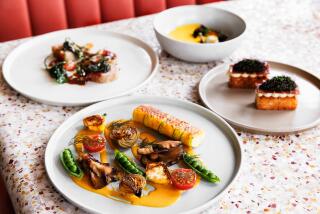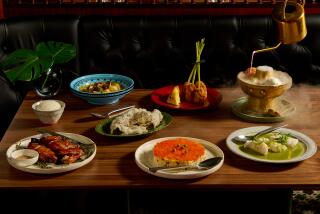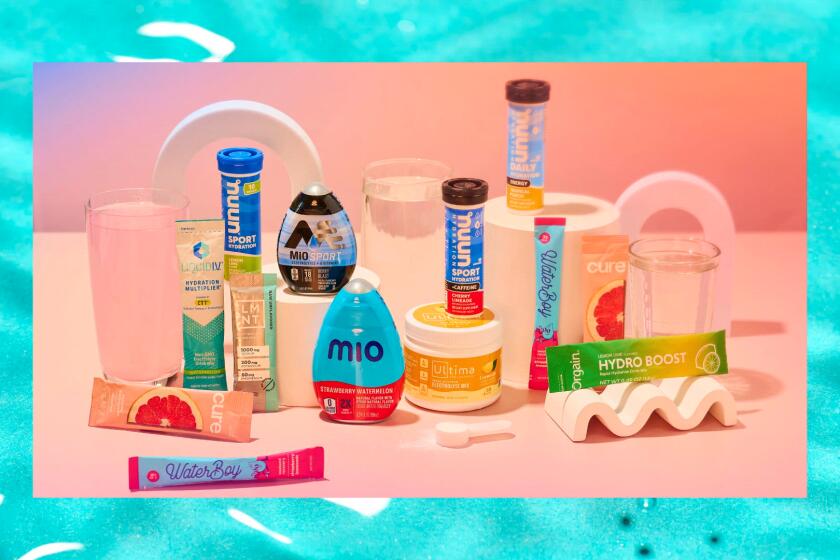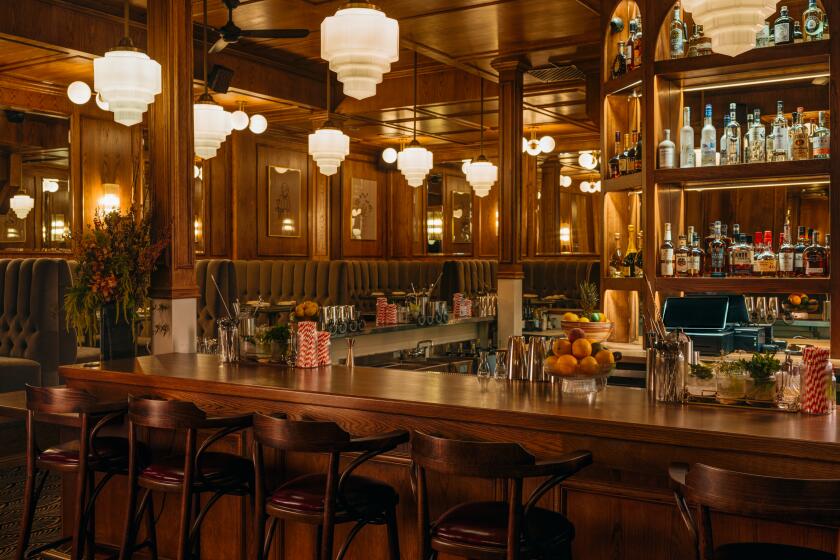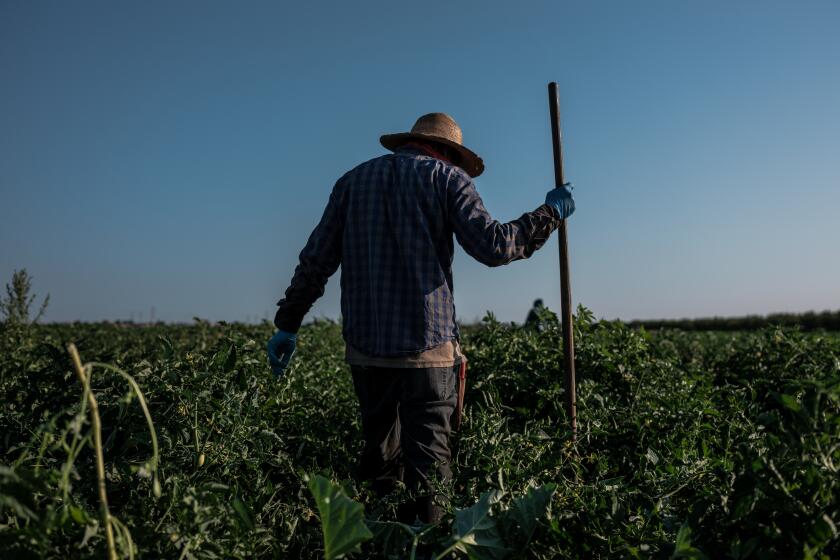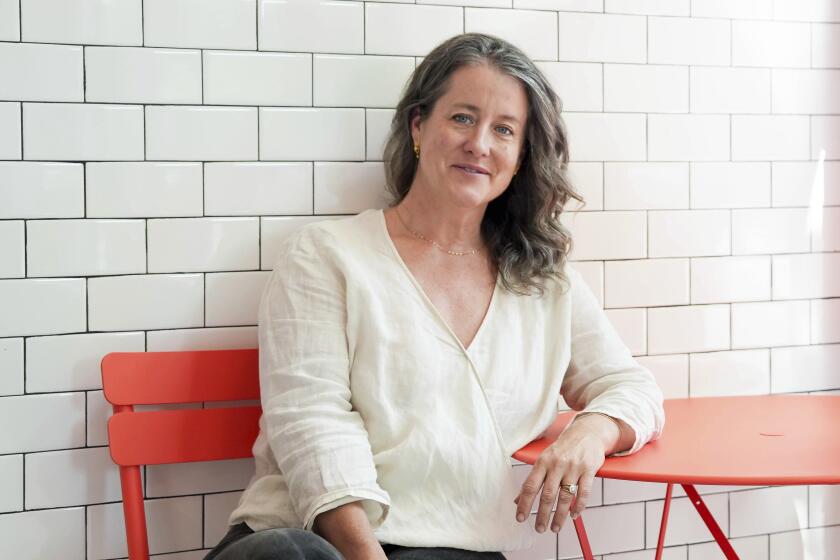In Celebration of Restaurants Past : Restaurant History : Eating in Los Angeles: The First Golden Age
In 1913, in an article in Smart Set magazine, Willard Huntington Wright--who had previously been chief literary critic for this newspaper--wrote this of Los Angeles dining habits:
“The spirit of (the city’s) provincialism is nowhere better shown than in (its) restaurants and cafes. These eating places are little more than magnified village lunch rooms. The most popular ones are those which serve the largest portions. The gastronomic ideals are simplicity and quantity. . . . The average resident of Los Angeles has an ingrained suspicion of ornamental and extravagant cooking. Nor is he sufficiently rakish to order an entree with which he is unfamiliar. . . .”
And just in case he hadn’t made his point, Wright continued: “Cooking in Los Angeles has none of the essentials of an art. There is no delicacy, no desire to please the eye, no imaginative combinations, no rare and savory dishes copied from the aristological lore of European kitchens.”
Either Wright was just being curmudgeonly, or things improved mighty fast around here, because by 1922 Otis M. Wiles was able to write, in The Times itself, that “a meal can be enjoyed (in Los Angeles) in an atmosphere of any nationality, prepared and served according to the custom of the country which the repast represents. The palate may be tickled by filet mignon grilled by imported French chefs; it may be delighted with highly flavored Oriental delicacies; by the gastronomic phenomenon created by true Italian chefs; by the culinary mysteries of the Russian kitchen; dinners typical of Old Spain and of Mexico, of China, Japan, Holland, and other nations where cookery customs are legend.”
*
It wasn’t all filet mignon and Chinese dinners, of course. Wiles also describes a restaurant of the time whose “interior resembles the Cabinet of Dr. Caligari, with the walls and ceiling smeared with a conglomerate mass of impressionistic paintings. Its owner was, a few months ago, the hat-check boy at another unusual place, where he amassed enough cash in tips to start a business of his own . . . . A Hawaiian orchestra plays jazz selections while a few small groups of long-haired youths toy with a dish of spaghetti and sip Turkish coffee as they watch the later arrivals enter through lop-sided doors and arrange their hair in lop-sided mirrors . . . .”
Cool.
And this wasn’t the only strange restaurant in L.A. According to Katherine Ames Taylor in “The Los Angeles Trip Book,” published in 1928, “Los Angeles affects the bizarre in many of her cafes. If you wish the Alice-in-Wonderland novelty of dining in a hat, there is the Brown Derby on Wilshire Boulevard, a replica of a gigantic brown derby. At 533 South Grand Avenue is the Bull Pen Inn, where you dine in stalls. There is the Zulu Hut on Ventura Boulevard, near Universal City, where knives and forks are dispensed with, and you dine most informally, in native fashion, eating fried chicken with your fingers. There are several ‘Jails’, one at Sunset Boulevard, one on 6th Street, which have bars at the windows and food is served by waiters in convict stripes. At the Log Cabin on Verdugo Road, you can have a game of checkers with your meals.”
L.A., in other words, was already starting to have fun with its restaurants. But it was also becoming, according to Taylor, “one of those few cities where you can dine out every night in the week and not rue it gastronomically.”
*
Because I grew up in these restaurants, I’m fascinated by their history, and by their lore and legend--and I’ve made an informal study of the subject over the years. One thing I’ve discovered, by going through menus dating from the 1930s, ‘40s and ‘50s, and reading restaurant guides and magazine and newspaper articles of the period, is that people probably ate pretty well around here in those days, at least by the standards of the time.
Here is some early local restaurant criticism, for instance, from “Curious California Customs” (sub-titled “What to Look For Besides Climate”) by Elisabeth Webb Herrick, vintage 1935: “Their little thin hot cakes and maple syrup,” writes Herrick of the Brown Derby, “have been silent factors in many a screen triumph where important studio executives ‘in conference’ have been soothed and stimulated by their deliciousness until the ‘dawn broke over the Hollywood Hills.’ ”
Of Perino’s, she muses: “It will always remain a mystery what these Italian restaurants do to string beans. This is something that no housewife can hope to achieve. Such bright, green tender and delicious-tasting morsels make vitamin-conscious folks completely satisfied for once with their lot.”
Of the rolls at the Otto Brothers Steak House, she writes: “They’re crisp and brown and hot and you can see the women furtively eyeing one another’s appetite for them. They know all about how much better good ol’ Rye Crisp is for them, bless you, but it takes real intestinal fortitude to forgo such delicacies.”
*
Herrick doesn’t mention Mike Lyman’s Grill (there were two locations, in Hollywood and Downtown, and Lyman also ran the Flight Deck restaurant at what was then the Los Angeles Municipal Airport), but a menu from the place, also dating from 1935, proves an astonishing document. To begin with, some 25 varieties of fish and shellfish were offered, including Coos Bay, Blue Point and Olympia oysters, English sole, striped bass, Catalina sand dabs, imported Irish salt mackerel and a dish called fried barracuda Maitre d’Hotel. (Then as now, there were probably more than a few maitres d’hotel around town at the time to whom both appellatives applied.)
The menu also listed appetizers ranging from kosher salami to terrine of foie gras, and soups including cold Russian borscht, onion soup au gratin and green turtle soup with pureed peas. About 20 varieties of steaks and chops were catalogued, as were about 20 salads--from sliced tomatoes to something called farmer’s chop suey--and exactly 14 kinds of potatoes.
On another Lyman’s menu, this one from 1944, the steaks and chops had pretty much disappeared--there was a war on, after all--but there were plenty of other delicacies: cold sweet-and-sour salmon, Colorado “snow-water rainbow trout” with sauce meuniere , individual boneless rock bass fried in butter, bouillabaisse Marseillaise (described helpfully as “assorted shell fish French dinner”) and whole boneless squab stuffed with rice Piemontese (which just might be risotto).
During the same era, Romanoff’s in Beverly Hills was happy to provide the diner with Russian beluga caviar (at a whopping $3 per portion), salade Nicoise , calf’s brains or the naughty-sounding deviled turkey Casanova for two. Le Chapeau Rouge in Hollywood, meanwhile, served tripes a la mode de Caen , sauteed frogs’ legs with fines herbes and stuffed grouse. Martial Poirier, owner-chef of the establishment, raised his own chickens, pheasants and guinea hens, and cooked his vegetables, he bragged, “just long enough to be edible.”
*
Romanoff’s was famous as a celebrity hangout, and show-biz glamour was certainly an important element on the Hollywood restaurant scene. One thinks of the Barclay Kitchen (where regulars had keys to the locked front door), the Gourmet (in the patio of a building owned by Edgar Bergen), the Brown Derby (brainchild of Herbert Somborn, one of Gloria Swanson’s husbands), Lucey’s (which a guidebook of the late 1940s called “one of those picturesque restaurants that tourists love because they never know when they may find Barbara Stanwyck and Bob Taylor sitting at the next table, with Joseph Cotten just beyond . . . “), Peppino’s (where, the same guide noted, “You are . . . likely to find . . . Richard Arlen, Olivia de Havilland or Harold Lloyd eating spaghetti”) and King’s (where Hedda Hopper and Louella Parsons could often be spotted), among others.
But restaurants weren’t serving glamour alone. The Marcus Daly in Beverly Hills served its own early version of capital-A American Cuisine, with a menu listing chicken shortcake on corn bread with baked ham and fresh mushroom sauce, tournedos of beef Baltimore with fried tomatoes, Kentucky-style turkey (in a light paprika sauce with mushrooms, pimientos and that old Bluegrass favorite, pineapple) and a dish labeled the chef’s own casserole--which was a mixture of chicken breast, beef brisket, assorted fresh vegetables, beef marrow and chives, accompanied by cheese rolls. (Ah, Marcus Daly, where are you today?)
There was more Americana at the Tail O’ the Cock restaurants on Restaurant Row and in Studio City, with broiled Catalina swordfish, pineapple fritters with homemade country sausage and scalloped capon with Virginia ham and fresh peas in Sherry cream sauce. The Naples in Hollywood, meanwhile, was one of a number of L.A. restaurants that had started flying in fresh seafood from the East Coast several times a week. They also served fresh soft-shell crabs in season and made their own sausages and pickles.
*
The menu at Paul’s Duck Press, near downtown, was a treasury of “Continental” specialties: abalone stuffed with crab meat, scallops and shrimp, venison marinated in red wine, and littleneck clam risotto, not to mention Romaine a la Paul--which proprietor Paul Maggiora claimed was the original Caesar salad. (According to “Dining Out in Hollywood and Los Angeles” by Craig Davidson, published in 1949, the Caesar moniker was given to the salad “by Paul’s former partner in Mexico whose brother bore that name.”)
That Los Angeles, in other words, had access to a lot more than just meat and potatoes. Despite the deprivations of the wartime years, the 1940s may have been something of a First Golden Era for L.A. restaurants.
Then I came along.
My first L.A. restaurant--my first restaurant of any kind--was Chasen’s. I was introduced to the place, almost 50 years ago, not by George Burns or Alfred Hitchcock or Ronny (as he was then known) Reagan or any of its other famous customers, but by a couple of show-biz-connected regulars whom I later came to know as Mom and Dad. I was a couple of months old at the time, and the meal I consumed came out of a baby bottle and not out of the then-celebrated Chasen’s kitchen.
*
I soon became a regular at Chasen’s myself--on the wall of the restaurant’s front room there was even for a time a photograph of me as a toddler, seemingly engaged in serious conversation with fellow toddler Peter Ford (actor Glenn Ford’s son)--and at a good many other local establishments. My parents were not sophisticated eaters--they liked their meat well done, drank milk with their dinner (cocktails came first) and loathed garlic and its relatives; their culinary heroes weren’t Escoffier or even Mrs. Rombauer, but rather Dinty Moore and Mary Kitchen--but they were avid restaurant-goers, obviously in love with the social aspects of the dining experience. They went out a lot and often took me along.
By the time I was 8 or 10, I knew my way through the menu (and through the dining room to the men’s room) not just at Chasen’s but at the Brown Derby, Armstrong-Schroeder, the Kings (where I encountered my first live lobster tank and discovered, probably to my parents’ amazement, that the idea of picking out the creature I was going to eat didn’t bother me one bit), the House of Murphy, the elegant dining rooms at the Bel-Air, Beverly Wilshire and Beverly Hills hotels, and more.
I’d go to tea rooms such as the El Encanto in Westwood with my mother when she went shopping (I remember little sandwiches on crustless toast), and, if I was good, I’d get taken to the original Southern California Blum’s, on Camden Drive in Beverly Hills, where the attraction was a kind of devil’s salad bar--a do-it-yourself sundae cart full of various ice creams and toppings of every sort, from hot fudge and caramel and fruit sauces to nuts and nonpareils and whipped cream.
I’d go to the studios where my father worked and lunch with him in the commissaries--they’d always save him some French apple pie at 20th-Century Fox, I remember--and at Hollywood hangouts like Lucey’s on Melrose. At Lucey’s (not to be confused with Lucy’s El Adobe, which is in the same neighborhood but unrelated), my father later told me, more show business careers had been made and broken than on any studio lot in town. I was personally more interested in the restaurant’s Monte Cristo sandwiches, of which I became something of a connoisseur.
*
I was also a big fan, at various restaurants, of breaded veal cutlets, chicken croquettes, O’Brien potatoes and, of course, that wonder of a dessert known as the snowball--vanilla ice cream rolled in coconut and topped with hot chocolate sauce. I even liked calf’s liver at an early age--almost certainly because my mother, with a bit of clever psychology, always described it to me as “liver steak ,” and steak seemed like a reasonable enough thing to eat.
A bit later, I became enamored of “Trader” Vic Bergeron’s local outpost in the Beverly Hilton Hotel, originally called the Trader’s and then renamed to become another Trader Vic’s. Here, I liked anything deep-fried and anything with a sweet, lacquery finish (pork slices and spareribs, for instance). My favorite dinner, though, was a platter containing a hamburger patty, a toasted English muffin, a fried banana and shoestring potatoes.
Later still--and continuing the South Seas theme--my favorite restaurant became a place called Samoa House. I don’t remember exactly where it was, except that it was in the San Fernando Valley, and--maddeningly, and uncharacteristically--I don’t remember a single thing I ate there, or even a single thing listed on the menu. All I know is that, for at least a few years of my life, I would have rather eaten there than anywhere else in the world.
More to Read
Eat your way across L.A.
Get our weekly Tasting Notes newsletter for reviews, news and more.
You may occasionally receive promotional content from the Los Angeles Times.
